Abstract
At the moment there is such situation at which at the macro level economic indicators are more or less obvious and are more studied, and the analysis of factors and systematization of approaches to studying of development of regions of Russia remains not ended so far. Today, the dynamics of the key indicators characterizing regional economies remain non-uniform that generates strong differentiation of subjects of the country on welfare and potential of economic development. In this regard, identification of the priority directions within certain branches of the economy and the advanced regional territories which can be sources of reproduction, attractions of resources and to act as a key link of highly competitive social and economic environment of the region is, today, a relevant task within the formation of innovative economy in Russia. Also, in connection with an urgent need to transition of the Russian economy to a trajectory of sustainable development, it is necessary to provide first of all qualitatively development of regions of the country: involvement of the lagging behind Russian regions in innovative processes to create strong economic relations between large poles of growth and local regional points of growth. The relevance of this research consists in performance of empirical verification of various concepts of convergence on the basis of the main socio-economic indexes of territorial subjects of the Russian Federation given about dynamics, decomposition of economic growth in regions of the Russian Federation and also in the assessment of dynamics of labor productivity in Russian regions.
Keywords: Differentiation of subjects of the countryeconomic growtheconomy of regionsinnovationssocial development
Introduction
The problem of development of regions of the country began to be considered actively during an industrial era. Reason of emergence of such problem and extensive discussion, it is considered to be manifestation of two tendencies. First tendency is based on the formation of such economic categories as development and effective development before which emergence development something was considered as just the conscious activity of the individual directed to the realization of the abilities (Barkhatov & Pletnev, 2016). Second tendency is based on basic change of views of the state territory, which began to be perceived as the certain platform uniting productive forces of the state subsequently (Santangelo & Stucchi, 2018). The tendency of uneven development of various territories of the uniform state began to be traced on this historical piece (Gordeeva, Esengeldin, & Khusainova, 2017).
Understanding of the state and the emergence of his new function as regional development, according to the strategy of social and economic development of the territories was created owing to the tendencies, which have appeared at that time.
If to speak about the present, then there is such situation at which at the macro level economic indicators is more or less obvious and are more studied, but the analysis of factors and systematization of approaches to studying of development of regions of Russia remains logically not ended (Kaneva & Untura, 2018).
There is obviously a fact that the dynamics of the economic basic indicators characterizing regional economies remain nonuniform for this moment: as well as on a recession stage, and during economic recovery. It generates strong differentiation of subjects of the country on welfare and potential of economic development (Michurina, Dubinina, & Barmina, 2018; Samphantharak & Townsend, 2018), which amplifies because of differences in climatic conditions and in the uneven placement of minerals, etc. (Koreva & Tikhiy, 2018).
In this regard, identification of the priority directions within certain branches of the economy and the advanced regional territories which can be sources of reproduction, attractions of labor and financial resources; and also centers of innovation and technological developments; to act as a key link of the highly competitive social and economic environment of the region is, today, a relevant task within the formation of innovative economy in Russia. Also, high relevance of this research consists in performance of empirical verification of various concepts of convergence on the basis of the main socioeconomic indexes of territorial subjects of the Russian Federation given about dynamics, decomposition of economic growth in regions of the Russian Federation and also in the assessment of dynamics of labor productivity in Russian regions.
Problem Statement
Dynamics of economic development of regions of Russia depends on external and internal factors which influence is differentiated in space. The policy of the federal authorities which role is especially big in the period of system, in particular political and economic transformations of economic system belongs to external factors. In addition, it is possible to refer impact of globalization and inclusion of Russia in the world market to external factors as one of the key subjects of world economy. The influence of global economy extremely unevenly extends on the territory of the country (Benz & Silova, 2017; Benz & Silova, 2015), namely the emphasis on the choice of the center of development happens in the largest cities, regions to production of the resources demanded in the world market or to a favorable geographical location for development of external relations. The condition of their labor market, the income of the population, regional and local budgets depend on the degree of inclusiveness of economy of regions in global commodity market and services.
The inherited features of its development since the existence of the Soviet Union remain the most important internal factor of economic development of regions. This dependence is shown in developed in the region of structure of economy, the degree of familiarity of the territory, a demographic situation, sociocultural features of the population and informal institutes influencing employment forms, income, mobility of the population, and in wider plan – on a human and social capital. The factor of the inherited features often is underestimated as the Soviet state planned economy the new cities and the enterprises were created without features of the territory.
In the course of transition from a state planned economy to the market considerable part of them was impractical, namely a set of the monotowns which did not adapt to conditions of the new economic system, in particular, many enterprises placed without real costs (transport tariffs, a condition of infrastructure, quality of labor, etc.) could not adapt to new conditions (Kapkaev & Sorokin, 2018). The influence of the inherited features of development is extremely large and largely determines the development potential of a particular region in a market economy. The policy of regional authorities is another internal factor of economic development, since it is a product of the inherited institutional environment and accumulated human capital, on which qualitative characteristics of the elite and the type of political regime in the region depend.
There is an opportunity to understand why transformations in regions went and still go a different speed, and at times and diversely at complex assessment of the influence of the inherited development, the institutional environment and policy of the regional authorities (Barkhatov, Pletnev & Campa, 2016).
In the practice of research of regional economy, allocate four main directions of differentiation of territories, namely:
The center—the periphery;
The West—the East (older industrial regions and regions of new development);
The North—the South (resource and industrial and agrarian regions);
The Russian kernel–the regions, which were more modernized, and more traditionalists.
Relative strengthening of capital cities, export and raw and certain boundary regions on the ways of the main trade streams, emergence of depressive regions and increase of backwardness underdeveloped became result of joint influence of the external (transformational) and inherited factors (Rating of socio-economic position of subjects of the Russian Federation, 2017).
The rating of social and economic development of the territories of the Russian Federation following the results of 2017 is represented in the table
The spatial picture of social and economic development during a transition period became extremely mosaic, namely passed the new characteristics (opened and the regions closed for global communications to the inherited territorial types of regions (the old developed industrial regions, resource-extraction regions of new development, the southern agrarian-industrial regions)), amplified inter regional сentro – peripheral distinctions, especially between Moscow and other regions. Growth of сentro – peripheral inequality also happens in regions. The regional centers and the cities of export branches adapt to new conditions much quicker, than the cities with a smaller population and the rural zone. Regional inequality increases in income, availability of education and other socially important services.
The significant role for economic development of the regions of Russia is played by introduction and active use of innovations. The increasing role of innovations is caused by the nature of the market relations and also need of deep high-quality transformations for economy of regions for the purpose of overcoming crisis and an exit to a trajectory of a steady rise. It is possible to tell that social and economic development of regions of Russia is caused by a set of a set of factors, the analysis and which systematization has high relevance for creation of the innovative housekeeper of Russia at the present stage of development proceeding from the above-described tendencies in regional growth of Russia.
Research Questions
In this research, it is necessary to solve a number of questions based on the above-described tendencies in social and economic development of regions of Russia, namely
To reveal the main problems of social and economic development of regions and modern Russia;
To reveal points of economic growth of regions and to offer their typology;
To offer a package of measures for activation of points for the economic growth of regions of Russia, using innovative approaches.Please replace this text with context of your paper.
Purpose of the Study
It is necessary to provide high-quality development of regions of the country in communication because of the urgent need to transition of the Russian economy to a trajectory of sustainable development. Therefore, involvement of the lagging behind Russian regions in innovative processes to create strong economic relations between large poles of growth and local regional points of growth is necessary. Proceeding from it, the purpose of this work is a systematization of theoretical approaches to the analysis of regional points of growth and the offer of practical actions for their activation.
Achievement of a goal is characterized by the high importance not only from the point of view of regional growth of territories, but also from the point of view of the development of Russia in general. It is caused by the fact that growth points in Russia began to be formed even during transition from a state planned economy to market. The specific territorial structure of Russia influenced the emergence of points of regional growth, as its geographically big sizes were objective factors of implementation of development of territories in the form of the separate centers, which formed around themselves the developed territories. Thus, the Russian territorial and economic space were initially strong deferentially and, today, actually represents a peculiar system of poles of growth where the regional and municipal centers performs the function of the organizing beginning for all adjacent territories. However, within transition from a state planned economy to the market a significant amount of backward and depressive regions appeared (Koreva & Tikhiy, 2018). It leads to emergence of acute contradiction between territorial development and the basic principle of federalism, which is that all territorial subjects of the federation have to be equal among them, and equal access to the benefits has to be provided to the population.
Research Methods
Within this research such methods as laws of formal and dialectic logic, identification of relationships of cause and effect and also methods of the system, logical, evolutionary analysis were applied. Besides, when processing, analytical and statistical material such research methods as problem and chronological, systemic-functional, dialectic, graphic and also methods of scientific generalizations and receptions of the economic and statistical analysis, in particular, a method main a component, hierarchical classification which application allowed to provide validity and reliability of the received theoretical conclusions and the developed practical offers were used.
1) Key problems of social and economic development of Russian regions were revealed and systematized on the basis of the analysis of the existing approaches to the analysis of regional growth.
Organizational problems consist in the inefficient interaction between the new and already operating in the territory enterprises and in under exploitation by the existing enterprises of resources of the region, and first of all labor;
Investment problems consist in lack of regions of opportunities for attraction of considerable investments (Rastvortseva, 2017) and, as a result lack of a possibility of updating physically and obsolete business assets of territorial and production complexes;
Financial problems consist in lack of large financial flows that promotes delay of development of cluster educations. It is caused by the absence of large players on in the region;
Innovative problems consist in lack of the effective mechanism of modernization of small business. The reason for that consists in the lack of the effective mechanism of diffusion of innovations between small enterprises.
2) Points of economic growth in the region were revealed by way of integration of certain groups of indicators on the basis of use the cluster approach. Identification of points of economic growth it is schematically shown in the Figure
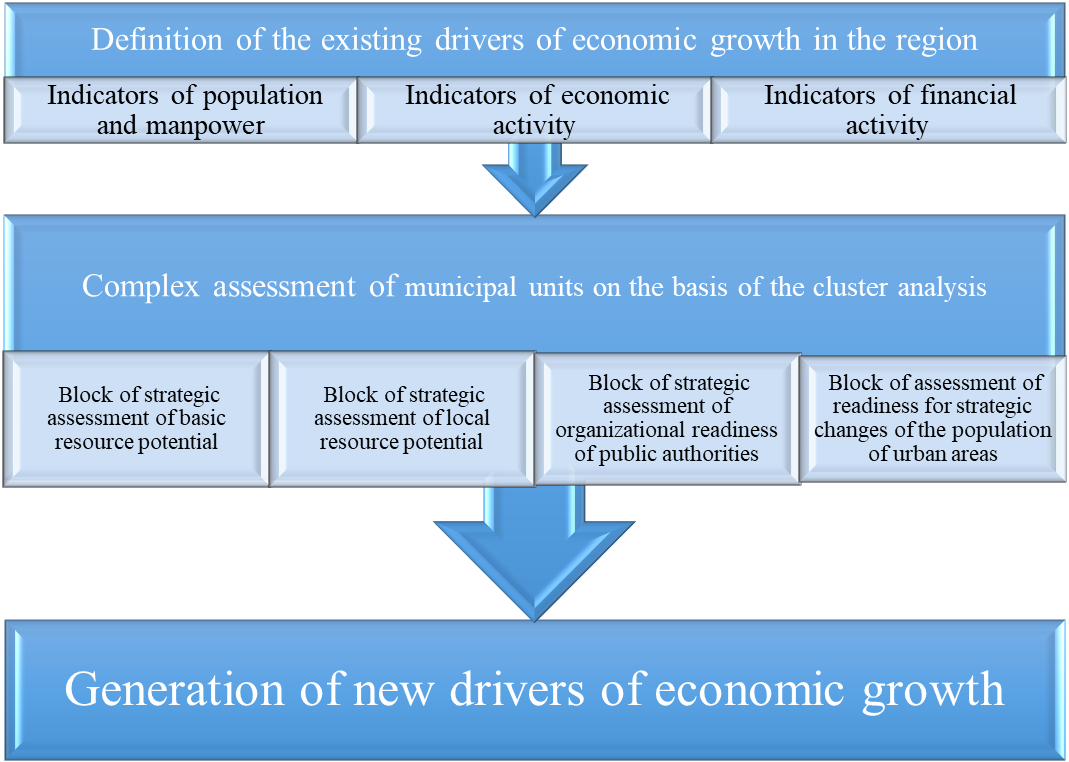
Source: Authors
The technique of generation of new drivers of economic development of the region consists of three stages.
At the first stage, it is necessary to reveal and analyze the existing drivers of economic growth of the region. Here it is necessary to reveal such indicators as the indicator of population and manpower, the indicator of economic activity, the indicator of financial activity. The detailed characteristic of the listed indicators is specified in the Figure
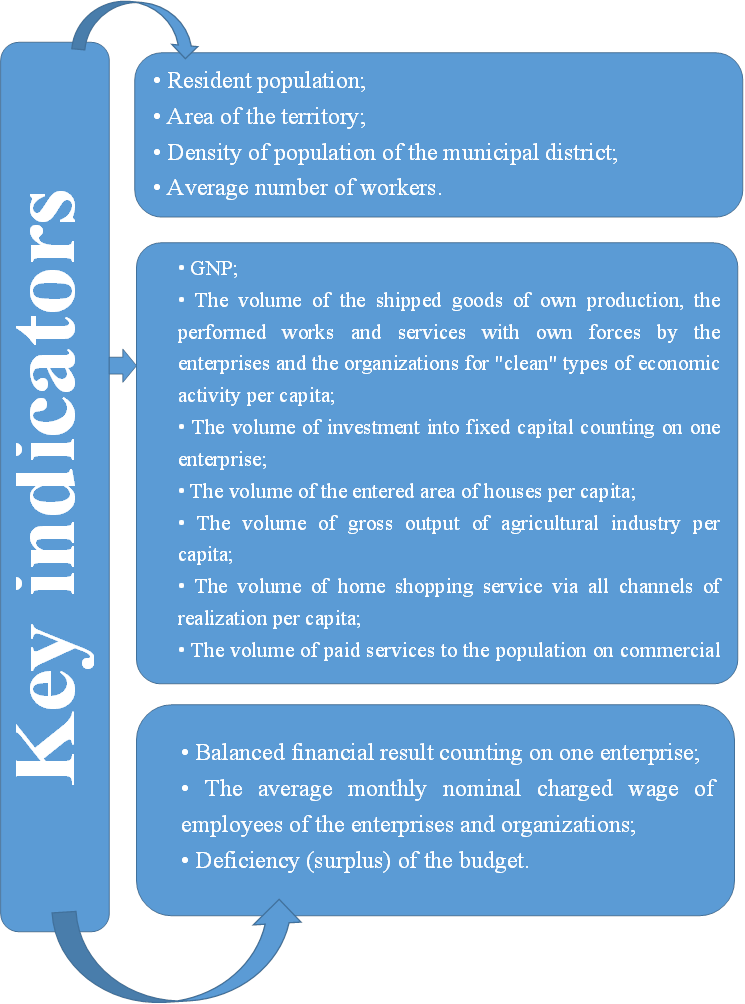
Essential differentiation of regions on the key indicators characterizing their economic development demands allocation of typological uniform groups of objects. Only in uniform groups of regions, it is possible to estimate qualitatively and adequately influence of various factors on economic development, to study structural regularities inherent in these groups of regions, to allocate regions, perspective from the point of view of investments. That is and the factors defining it is expedient to conduct research of regional economic growth in Russia in typologically uniform groups of the regions having common features and regularities of development of economic processes therefore it is expedient to carry out the analysis of key indicators of economic growth on the example of regions of the Urals Federal District.
Findings
The above-described algorithm of definition of drivers of economic development of the region was carried out on the example of Chelyabinsk region in comparison with other regions of the Urals Federal District.
These indicators of the first group of indicators are given in the figure
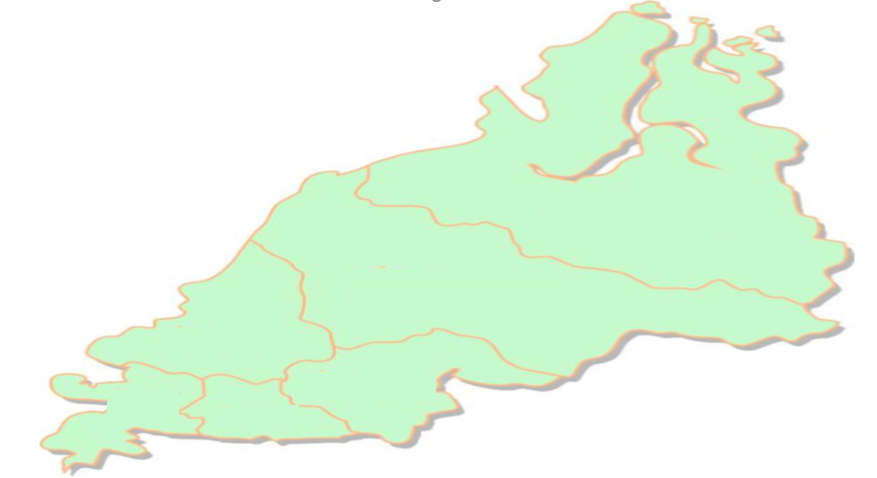
Further comparative assessment of some indicators of the second and third group of indicators of Chelyabinsk region in relation to other regions of the Urals Federal District is given (Figures
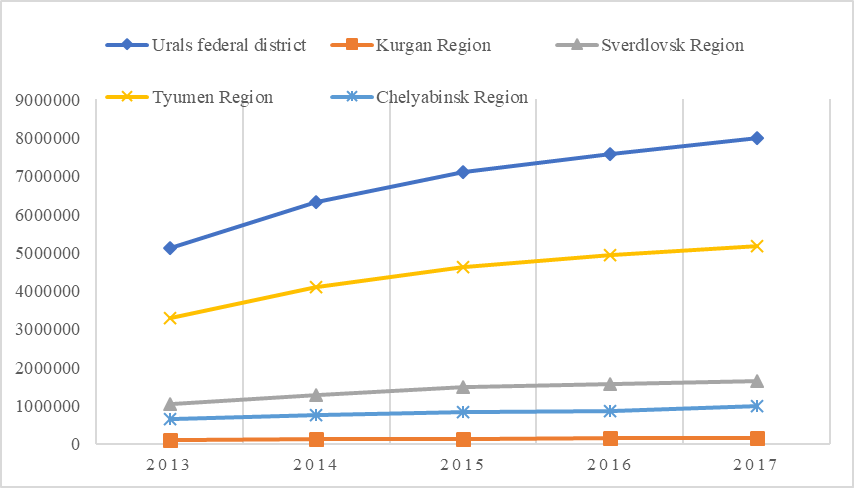
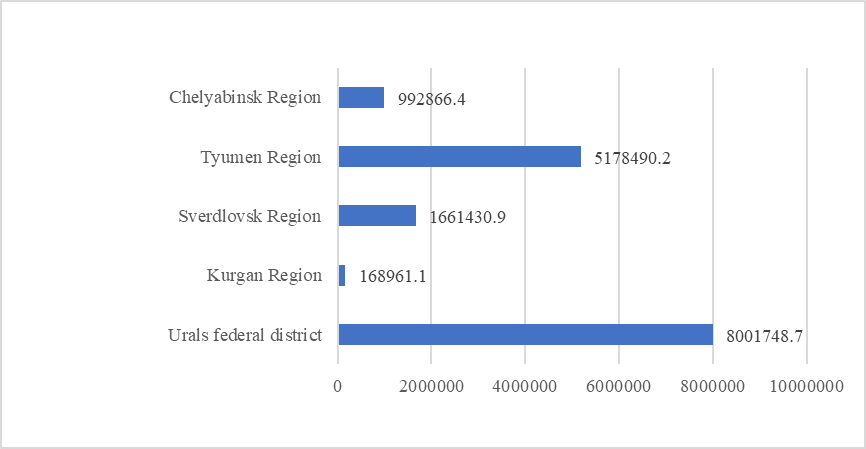
The gross regional product is the generalizing indicator of economic activity of the region, defines its effectiveness and characterizes again created cost of the goods and services made in the territory of the region (Moscvina, Filimenko & Likhacheva, 2017). Chelyabinsk region among typologically similar regions on this indicator takes the third place, conceding to the Sverdlovsk and Tyumen regions.
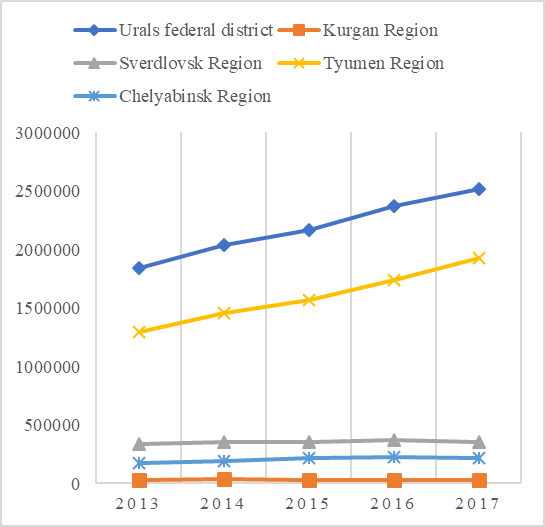
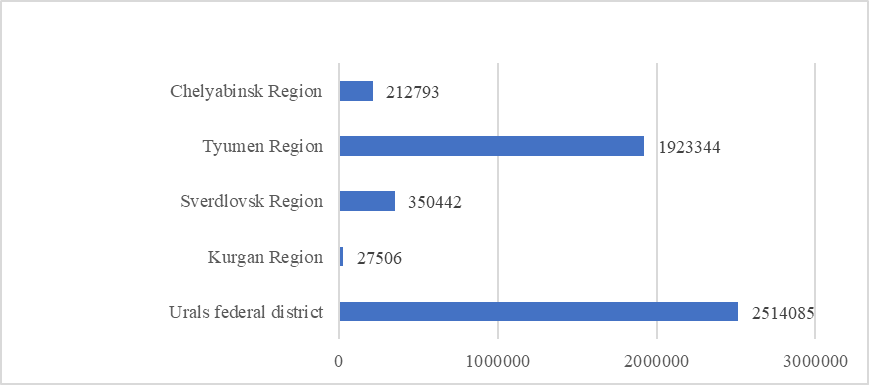
Investments into fixed capital of any enterprise are the main driving force, on a straight line influencing a growth in volumes of production and economic solvency. And in country scales the condition of the investment sphere determines rates of economic and social development of the country, the technological level of production and its efficiency, competitiveness in the world markets and as a result – qualitative characteristics of a level of living of the population. Chelyabinsk region among typologically similar regions on this indicator takes also the third place, conceding to the Sverdlovsk and Tyumen regions (Figures
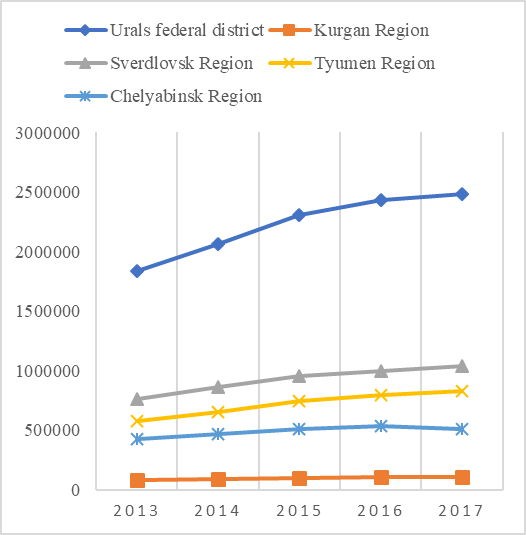
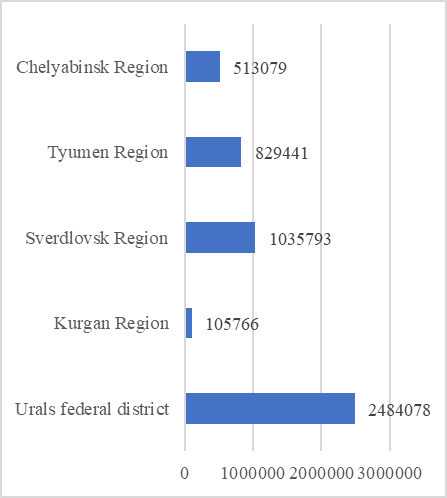
Retail trade is an important link on the commodity market, which is intended for the service of the population and rendering services to buyers (Figures
By quantity of the average monthly nominal charged wage of employees of the organizations Chelyabinsk region takes the fourth place, it is less than average on the Ural region (Figures
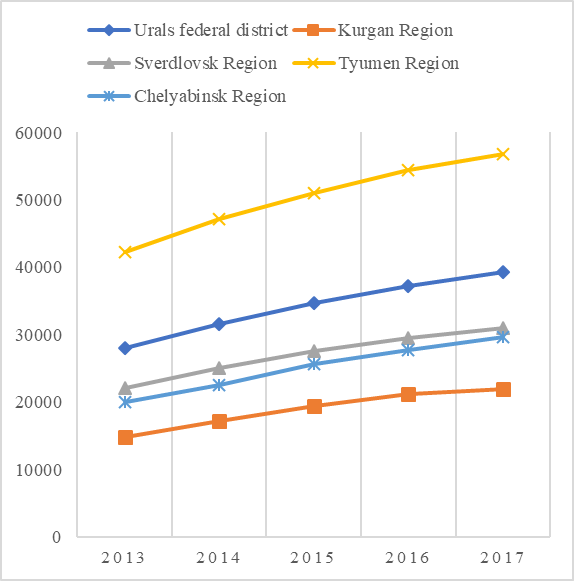
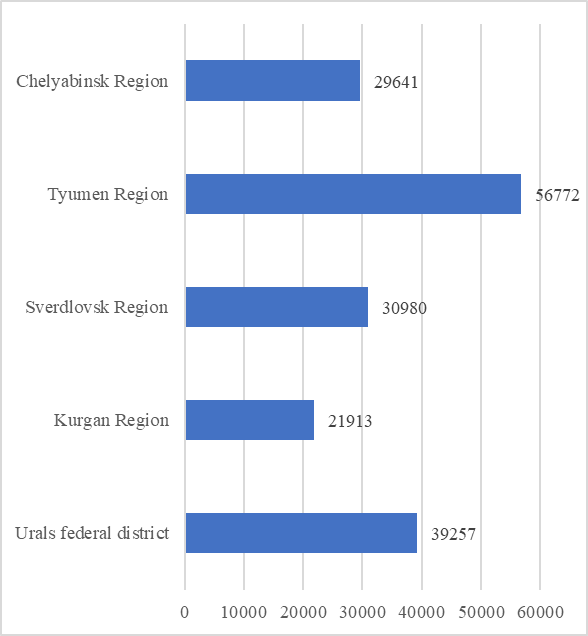
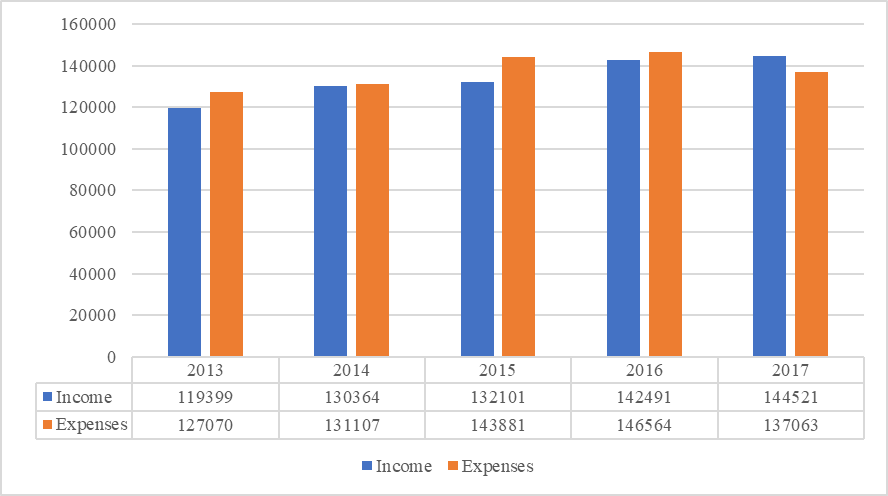
The revenues of the budget of Chelyabinsk region in 2017 made over 144 billion rubles, and account over 137 billion (Figure
On the basis of the carried-out analysis of the allocated indicators of regional growth it is possible to say that the economy of Chelyabinsk region on many indicators is on the third position within the Urals Federal District. Undoubtedly, one and key points of growth in the region the agricultural industry, which shows steady growth rates in recent years is. But for sustainable development of one or two drivers of growth it is not enough therefore it is necessary to range the perspective directions of development (potential drivers of economic growth) depending on their capacity and compliance to strategic objectives of development of the region, to inventory all resources which are available in the region, in particular administrative, political, financial, intellectual, social and to mobilize them for creation of those new drivers of economic growth.
Conclusion
Based on results of the analysis of the existing problems of social and economic development which is carried out above at the regional level it is possible to draw the following conclusion, regional programs of economic growth represent the highly sensitive specific areas of selective influence localized in space and time which are made active by means of economic, organizational and administrative and social and psychological methods of management capable to release and turn specific potentials of social and economic development into progress.
At the same time, such programs are not always the centers of concentration of various potentials, and often their activation is a point of application of efforts and mostly depends on the organizational and legal sphere, a compromise between interests and opportunities of the federal center and regional governing bodies. In these conditions realizations of policy of cluster development in Russian regions by transfer of a number of powers from the federal center is possible for regions and support on the implementation of development programs of regional points of growth by means of indirect instruments of regulation. In this case, local authorities will receive more independence and motivations in carrying out active economic policy and will concentrate efforts on innovative development of the territories. Thus, the carried-out analysis of the main signs, shortcomings and advantages of regional policies allowed to prove a possibility of implementation of the policy of the accelerated development of the region, using the best parts of other regional policies. Activation of the regional drivers of growth will allow for increasing efficiency of the organization of regional government, efficiency of the use of financial resources and to concentrate regional resources on the priority directions.
References
- Barkhatov, V., Pletnev, D., & Campa, A. (2016). Key Success Factors and Barriers for Small Businesses: Comparative Analysis. Procedia – Social and Behavioral Sciences, 221, 29-38.
- Barkhatov, V., & Pletnev, D., (2016). Business Success of Small and Medium Sized Enterprises in Russia and Social Responsibility of Managers. Procedia – Social and Behavioral Sciences, 221, 185-193.
- Benz, D., & Silova, E. (2015). Imperfection of the Contractual Relations in the Regional Agrarian Sector. Mediterranean Journal of Social Sciences, 6 (5), 615-624.
- Benz, D., & Silova, E., (2017). Model of Region’s Food Security in Russia. Eurasian Studies in Business and Economics, 4, 217-229.
- Gordeeva, E., Esengeldin, B., & Khusainova, Z. (2017). State Programming of Innovation Development of Economy: Macrostructural Priorities, Institutional and Economic Specification. Journal of Advanced Research in Law and Economics, [S.l.], 8(6), 1767-1778.
- Kaneva, M., & Untura, G. (2018). Interrelation of R&D, Knowledge Spillovers, and Dynamics of the Economic Growth of Russian Regions. Regional Research of Russia, 8(1), 84-91.
- Kapkaev, Y., & Sorokin, D. (2018). The implementation of the comfortable investment environment on the basis of the effectiveness assessment of the corporation. Procedia - social and behavioral sciences, 238, 697-703.
- Koreva, O., & Tikhiy, V. (2018). Innovative development of regions of Russia: opportunities and barriers. Advances in Economics, Business and Management Research (AEBMR), 39, 10-13.
- Michurina, O., Dubinina, N., & Barmina, E. (2018). Elements of the "new economy" and innovative development as strategic priorities for strengthening the competitive position of the regions Advances in Economics, Business and Management Research (AEBMR), 39, 169-173.
- Moscvina, A., Filimenko, I., & Likhacheva, T., (2017). Economic value added as an indicator of regional economic growth. In References 4th International Multidisciplinary Scientific Conference on Social Sciences and Arts SGEM2017 (pp. 605-612). Sofia, Bulgaria: STEF92 Technology Ltd.
- Rastvortseva, S. (2017). Assessment of the innovation factors impact on economic growth in Russian regions. In Innovation Management, Entrepreneurship and Sustainability, Proceedings of the 5th International (IMES 2017) Conference (pp. 795-809). Prague, Czech Republic: University of Economics.
- Rating of socio-economic position of subjects of the Russian Federation (2017). [online]. Retrieved September 22, 2018 from: http://riarating.ru/infografika/20180523/630091878.html.
- Rosstat. (2017). Region of Russia socio-economic indicators. Statistical collection [online]. Retrieved September 24, 2018 from: http://www.gks.ru/free_doc/doc_2017/region/reg-pok17.pdf.
- Samphantharak, K., & Townsend, R. (2018). Risk and Return in Village Economies. American Economic Journal: Microeconomics, 10 (1), 1-40.
- Santangelo, G., & Stucchi, T., (2018). Internationalization through exaptation: The role of domestic geographical dispersion in the internationalization process. Journal of International Business Studies, 49(6), 753-760.
Copyright information

This work is licensed under a Creative Commons Attribution-NonCommercial-NoDerivatives 4.0 International License.
About this article
Publication Date
02 April 2019
Article Doi
eBook ISBN
978-1-80296-058-7
Publisher
Future Academy
Volume
59
Print ISBN (optional)
-
Edition Number
1st Edition
Pages
1-1083
Subjects
Business, innovation, science, technology, society, organizational theory,organizational behaviour
Cite this article as:
Barkhatov, V., Kapkaev, Y., Bents, D., Kadyrov, P., & Isaeva, A. (2019). Economic Growth Of Russian Regions: Condition, Factors, Opportunities. In V. A. Trifonov (Ed.), Contemporary Issues of Economic Development of Russia: Challenges and Opportunities, vol 59. European Proceedings of Social and Behavioural Sciences (pp. 430-444). Future Academy. https://doi.org/10.15405/epsbs.2019.04.47

